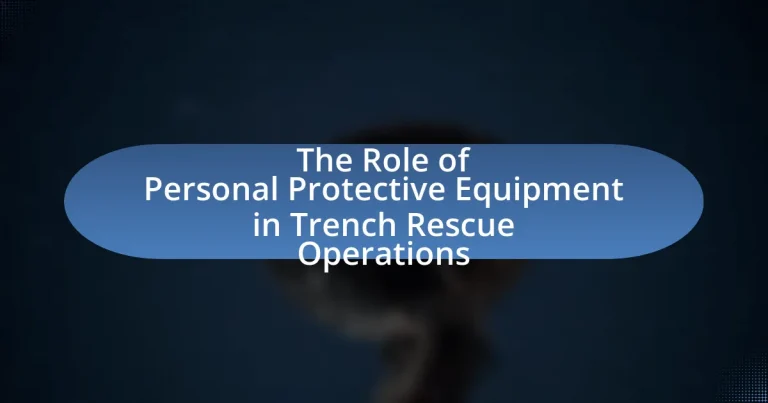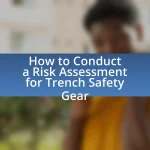Personal Protective Equipment (PPE) is essential in trench rescue operations, providing critical protection for both rescuers and victims against various hazards such as falling debris, cave-ins, and exposure to hazardous materials. The article outlines the specific types of PPE required, including helmets, gloves, and respiratory protection, and emphasizes the importance of proper training in the use of this equipment to minimize injury risks. It also discusses the challenges faced in using PPE, such as limited mobility and heat stress, and highlights best practices for ensuring safety during trench rescues. Overall, the effective implementation of PPE protocols is crucial for enhancing safety and operational efficiency in these high-risk environments.

What is the Role of Personal Protective Equipment in Trench Rescue Operations?
Personal Protective Equipment (PPE) plays a critical role in trench rescue operations by ensuring the safety of rescuers and victims. PPE includes items such as helmets, gloves, eye protection, and high-visibility clothing, which protect against hazards like falling debris, sharp objects, and exposure to hazardous materials. The Occupational Safety and Health Administration (OSHA) mandates the use of PPE in excavation and trenching activities, highlighting its importance in reducing injury risks. Studies indicate that proper PPE usage can significantly lower the incidence of injuries during rescue operations, reinforcing its essential role in maintaining safety standards.
How does Personal Protective Equipment enhance safety during trench rescue operations?
Personal Protective Equipment (PPE) enhances safety during trench rescue operations by providing essential protection against hazards such as falling debris, exposure to hazardous materials, and potential trench collapses. PPE, including helmets, gloves, and respiratory protection, minimizes the risk of injury to rescuers and victims alike. For instance, according to the Occupational Safety and Health Administration (OSHA), proper use of PPE can significantly reduce the likelihood of injuries in construction-related incidents, which includes trench rescues. The implementation of PPE protocols ensures that rescuers are equipped to handle the unpredictable nature of trench environments, thereby improving overall safety outcomes.
What specific hazards does Personal Protective Equipment protect against in trench rescues?
Personal Protective Equipment (PPE) protects against several specific hazards in trench rescues, including cave-ins, falling objects, hazardous atmospheres, and exposure to sharp or abrasive materials. Cave-ins pose the most significant risk, as they can lead to entrapment or suffocation; PPE such as helmets and harnesses mitigate these dangers. Falling objects, which can occur during excavation or from above, are countered by hard hats and eye protection. Additionally, PPE is designed to safeguard against hazardous atmospheres, including toxic gases or low oxygen levels, through the use of respirators. Lastly, gloves and protective clothing shield rescuers from sharp or abrasive materials that may be present in the trench environment.
How does the proper use of Personal Protective Equipment reduce injury risk?
The proper use of Personal Protective Equipment (PPE) significantly reduces injury risk by providing essential barriers against hazards encountered during trench rescue operations. PPE, such as helmets, gloves, and respiratory protection, is designed to protect workers from falling objects, hazardous materials, and environmental dangers. For instance, a study by the National Institute for Occupational Safety and Health (NIOSH) indicates that the use of hard hats can prevent head injuries in 85% of cases involving falling debris. Additionally, wearing appropriate gloves can reduce the risk of cuts and abrasions, while respiratory protection minimizes exposure to harmful dust and gases. Therefore, the correct application of PPE is crucial in mitigating risks and enhancing safety for personnel involved in trench rescue scenarios.
What types of Personal Protective Equipment are essential for trench rescue operations?
Essential Personal Protective Equipment for trench rescue operations includes hard hats, safety goggles, gloves, high-visibility vests, and steel-toed boots. Hard hats protect against falling debris, while safety goggles shield the eyes from dust and potential hazards. Gloves provide hand protection from sharp objects and chemicals, and high-visibility vests ensure rescuers are easily seen in low-light conditions. Steel-toed boots offer foot protection against heavy objects and provide traction on uneven surfaces. These items are critical for ensuring the safety of rescuers and victims during operations in potentially hazardous environments.
What are the key components of Personal Protective Equipment used in trench rescues?
The key components of Personal Protective Equipment (PPE) used in trench rescues include helmets, gloves, eye protection, high-visibility clothing, and respiratory protection. Helmets protect against falling debris, while gloves provide grip and protect hands from sharp objects. Eye protection safeguards against dust and debris, and high-visibility clothing ensures rescuers are easily seen in low-light conditions. Respiratory protection is essential in environments with hazardous gases or dust. These components are critical for ensuring the safety of rescuers and victims during trench rescue operations.
How do different types of Personal Protective Equipment serve various functions in trench rescues?
Different types of Personal Protective Equipment (PPE) serve critical functions in trench rescues by ensuring the safety and effectiveness of rescue operations. For instance, helmets protect rescuers from falling debris, while high-visibility vests enhance visibility in low-light conditions, reducing the risk of accidents. Additionally, respiratory protection, such as masks, safeguards against inhalation of hazardous materials that may be present in trench environments. Gloves provide grip and protection from sharp objects, and steel-toed boots prevent foot injuries from heavy equipment or debris. Each type of PPE is designed to mitigate specific risks associated with trench rescues, thereby enhancing the overall safety and efficiency of the operation.
Why is training on Personal Protective Equipment crucial for rescue teams?
Training on Personal Protective Equipment (PPE) is crucial for rescue teams because it ensures their safety and effectiveness during operations. Proper training equips team members with the knowledge to select, use, and maintain PPE, which is essential in hazardous environments like trenches where risks include falling debris, exposure to toxic substances, and potential injuries. According to the Occupational Safety and Health Administration (OSHA), effective training can reduce workplace injuries by up to 30%, highlighting the importance of understanding PPE in minimizing risks during rescue missions.
What training methods are effective for ensuring proper use of Personal Protective Equipment?
Effective training methods for ensuring proper use of Personal Protective Equipment (PPE) include hands-on demonstrations, simulations, and regular assessments. Hands-on demonstrations allow workers to practice donning and doffing PPE correctly, which is crucial for safety. Simulations provide realistic scenarios where workers can apply their knowledge in a controlled environment, reinforcing the importance of PPE in actual trench rescue operations. Regular assessments, including quizzes and practical evaluations, ensure that workers retain knowledge and skills related to PPE usage. Research indicates that training programs incorporating these methods significantly improve compliance and safety outcomes in hazardous environments, as evidenced by a study published in the Journal of Safety Research, which found a 30% increase in proper PPE usage among trained personnel.
How does training impact the overall effectiveness of trench rescue operations?
Training significantly enhances the overall effectiveness of trench rescue operations by equipping responders with essential skills and knowledge. Well-structured training programs improve situational awareness, enabling rescuers to assess hazards and implement safety measures effectively. For instance, the National Fire Protection Association (NFPA) emphasizes that trained personnel are more adept at using personal protective equipment (PPE) correctly, which is crucial in preventing injuries during rescues. Additionally, studies show that regular drills and simulations lead to faster response times and better coordination among team members, ultimately increasing the likelihood of successful rescues.
How can the effectiveness of Personal Protective Equipment in trench rescues be evaluated?
The effectiveness of Personal Protective Equipment (PPE) in trench rescues can be evaluated through performance assessments, compliance with safety standards, and incident analysis. Performance assessments involve testing PPE under simulated trench conditions to measure its durability, comfort, and protection levels against hazards such as falling debris or exposure to hazardous materials. Compliance with safety standards, such as those set by the Occupational Safety and Health Administration (OSHA) and the National Fire Protection Association (NFPA), ensures that the PPE meets established criteria for safety and effectiveness. Incident analysis examines past trench rescue operations to identify how PPE performed during actual rescues, including any failures or successes, which provides data for improving future PPE designs and training protocols.
What are the common challenges faced in using Personal Protective Equipment during trench rescues?
Common challenges faced in using Personal Protective Equipment (PPE) during trench rescues include limited mobility, inadequate fit, and heat stress. Limited mobility arises from bulky gear, which can hinder rescuers’ ability to maneuver in confined spaces. Inadequate fit can lead to gaps in protection, exposing rescuers to hazards such as falling debris or hazardous materials. Heat stress is a significant concern, as PPE can trap heat and moisture, increasing the risk of heat-related illnesses during physically demanding rescue operations. These challenges highlight the need for well-designed, properly fitted PPE that balances protection with functionality in trench rescue scenarios.
How can rescue teams overcome these challenges to ensure safety?
Rescue teams can overcome challenges to ensure safety by utilizing advanced personal protective equipment (PPE) specifically designed for trench rescue operations. This equipment includes helmets, harnesses, and respiratory protection that meet stringent safety standards, thereby reducing the risk of injury from falling debris or hazardous atmospheres. For instance, the National Institute for Occupational Safety and Health (NIOSH) emphasizes the importance of using PPE that complies with regulations to protect workers in confined spaces. Additionally, regular training and drills enhance the team’s preparedness, allowing them to respond effectively to emergencies while minimizing risks.
What best practices should be followed for using Personal Protective Equipment in trench rescue operations?
Best practices for using Personal Protective Equipment (PPE) in trench rescue operations include ensuring that all rescuers wear appropriate PPE such as hard hats, gloves, high-visibility vests, and respiratory protection. These items protect against falling objects, sharp edges, and hazardous atmospheres, which are common risks in trench environments. Additionally, conducting a thorough risk assessment before entering the trench is crucial to identify specific hazards and determine the necessary PPE. Training rescuers on the correct use and limitations of PPE enhances safety and effectiveness during operations. Regular inspection and maintenance of PPE ensure that it remains in good condition and effective for use. According to the Occupational Safety and Health Administration (OSHA), proper PPE usage significantly reduces the risk of injury in hazardous work environments, reinforcing the importance of these best practices in trench rescue scenarios.


